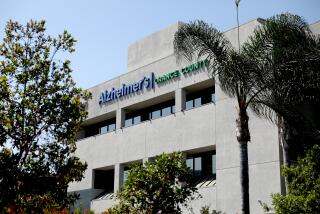She Tenderly Treats the High Hopes of Patients
- Share via
The minute the words “breakthrough” and “cure” started floating around, she knew what to expect. She’s seen it many times over her 16 years in cancer research and care.
The phones would begin ringing in her office at the City of Hope. Calls from patients pronounced incurable, others lingering in remission. Others frightened of treatments almost as loathsome as the disease.
All asking, pleading, “Dr. Margolin, will this help me?”
*
Raloxifene. Herceptin. Endostatin. Angiostatin. 13-cis-retinoic acid.
They’ve been front-page news in the last few weeks, part of a tidal wave of new cancer therapies that scientists say have the power to move understanding and treatment of the disease to a whole new level.
But it’s a long road from the laboratory to the doctor’s office . . . a road littered with patients’ hopes, raised then dashed.
It’s doctors like Kim Margolin who walk that road and confront those hopes.
“It happens the minute you get some new announcement” of a possible advancement in cancer care, she says. “People read the first couple lines, then come to you with these articles and say, ‘Is this for me?’ ”
In most cases, the answer is no . . . and the explanation is often mind-numbingly technical and heartbreakingly hard.
The reality is, the new breakthroughs are small--albeit important--scientific steps.
Important in that they represent a departure from the conventional surgery-radiation-chemotherapy approach used to manage most cancers. But incremental in that, in the view of many scientists, we are still far away from anything that could realistically be considered a cure.
And while we are making headway on several fronts in the battle against the nation’s second-most deadly disease, we are still largely outgunned.
“We’re curing higher numbers of adults with leukemia, testicular cancers, lymphoma . . . rare tumors that don’t account for the majority of adult cancers,” Margolin said.
But in terms of treating advanced stages of the most common cancers--of the lung, breast, colon, prostate--”we are barely on the Richter scale when it comes to [affecting] the mortality rate.”
*
Like many physicians at the City of Hope--one of the nation’s best-known cancer research centers--Margolin’s role as clinical oncologist is part teacher, part scientist, part judge.
It is heady and exciting work these days--evaluating laboratory experiments and supervising the clinical trials that every prospective treatment option must undergo.
But much of what Margolin spends her days doing has less to do with peering through microscopes than with watching the lives of real people crumble--as she confronts them with news of malignancies and metastases and helps them rebuild those lives.
It’s frustrating but fulfilling . . . a task that brings the cancer doctor full circle.
“It’s about teaching people to understand their disease and the rationale for the treatments we offer. . . . Sitting there in the room, explaining to someone and watching them begin to understand, then allowing them to participate in their treatment decisions. That’s the rewarding part of what’s generally a rather daunting experience.”
And while the recent flurry of scientific discoveries may not produce immediate advances in care, it has already expanded opportunities for patients willing to participate in clinical trials to test the new therapies.
Trials that may point researchers in new directions but may not save the patients’ lives . . . may not bear fruit until after they’re gone.
“It’s a gamble many cancer patients take,” Margolin says. And she admires as “heroic” those who choose it.
“They go in hoping that what they get will help them in some way. But generally they understand that maybe the most they will do is help someone else . . . down the line . . . .”
*
Sandy Banks’ column is published Mondays and Fridays. Her e-mail address is sandy.banks@latimes.com.






